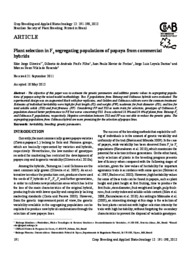Plant selection in F2 segregating populations of papaya from commercial hybrids.
Plant selection in F2 segregating populations of papaya from commercial hybrids.
Author(s): OLIVEIRA, E. J. de; FRAIFE FILHO, G. de A.; FREITAS, J. P. X. de; DANTAS, J. L. L.; RESENDE, M. D. V. de
Summary: The objective of this paper was to estimate the genetic parameters and additive genetic values in segregating populations of papaya using the mixed model methodology. Two F2 populations from Tainung and Calimosa hybrids were evaluated. The experimental design was an augmented block with four replicates, and Golden and Calimosa cultivars were the common treatment. Estimates of individual heritability were high for fruit length (FL) and weight (FW), moderate for fruit diameter (FD), and low for total soluble solids (TSS) and fruit firmness (FF). Considering FF and TSS as main traits for selection, genotypes of Calimosa-F2 population showed better performance to FF, but worse concerning TSS. It was selected 18.3% and 24.6% of plants from Tainung-F2 and Calimosa-F2 populations, respectively. Negative correlation between TSS and FF was not able to reduce the genetic gains. The segregating populations from Calimosa hybrid are more promising for the selection of papaya lines.
Publication year: 2012
Types of publication: Journal article
Unit: Embrapa Forestry
Keywords: Carica Papaya, Mamão, Melhoramento genético
Observation
Some of Embrapa's publications are published as ePub files. To read them, use or download one of the following free software options to your computer or mobile device. Android: Google Play Books; IOS: iBooks; Windows and Linux: Calibre.
Access other publications
Access the Agricultural Research Database (BDPA) to consult Embrapa's full library collection and records.
Visit Embrapa Bookstore to purchase books and other publications sold by Embrapa.

